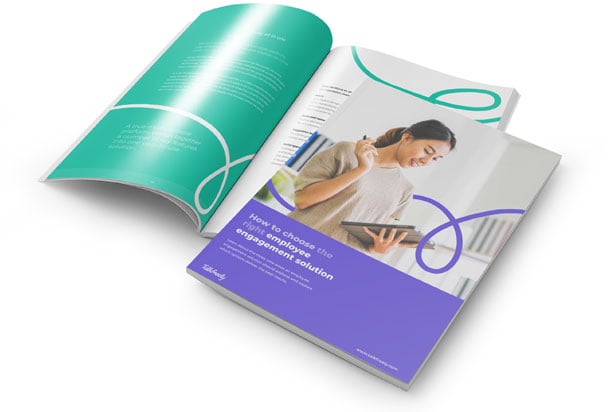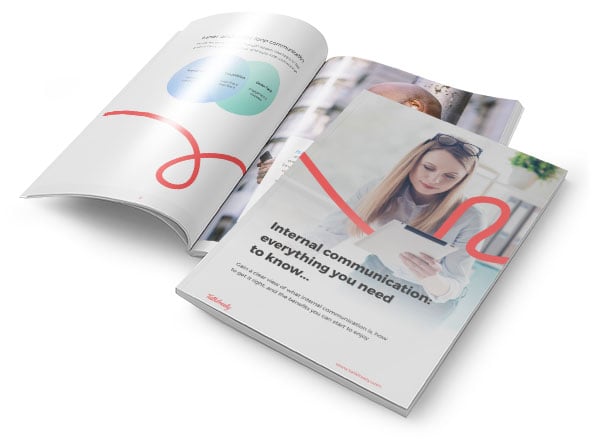Within the modern office, there is a constant flow of information. Managers are passing instructions down to their teams, the teams are communicating within themselves about the project in hand, and the teams are also feeding back their progress to management. There is a continuous flow of knowledge and data, circulating throughout the organisation. For the business to perform at its best, these internal communications need to be managed effectively.
Corporations with large numbers of staff and many levels of hierarchy can struggle to handle these internal communication channels and keep the flow running smoothly between superiors and subordinates. This is especially true in times of business disruption, such as the chaos caused by the recent pandemic. With urgent announcements taking priority over the usual scheduled messages there has been a tendency for internal communications to become a one-way street. But, now more than ever, it is vital to ensure that communication channels are flowing in all directions. Employees need to be able to speak, and have their voices heard.
In this blog, we take a look at the three methods of internal communication in the workplace and how each method is vitally important to the efficient running of your business.
The Three Internal Communication Methods
What is internal communication? Put simply, it’s the sharing of information within an organisation. However, unlike everyday communications, internal communication is goal orientated. The important thing to always keep in mind is that effective internal communication is about outcomes; ones that can be tracked and measured to determine their level of success.
There are three main methods of internal communication in business:

#1 Downwards
Communication from managers or leaders to employees
This is a flow of information that travels from the top to the bottom i.e. from the CEO downwards. It is employee communication that travels through senior executives to junior staff, from the head office to the local branches and from the head of the department to the team manager. It may take the form of an email, a letter, a memo or a verbal directive. Downward communication is the traditional method that many people instantly associate with internal communication.
Type of downward communication include:
- Corporate goals
- Mission statements
- Instructions
- Regulations
- Procedures
- Crisis updates
When communicating with employees with this method, it’s crucial that information is delivered in a clear and professional manner that leaves no room for misunderstanding. It’s helpful here to remember the three C’s of internal communication:
- Be clear
- Be concise
- Be compelling
Your job is to make sure that those calls to action and urgent instructions are translated into something that makes sense to employees. They need to have a clear understanding of what is required of them on receipt of the message.
The downward method is often used to communicate during times of change and crisis. Communicating change is a particularly challenging task that requires careful handling. The new ways of working need to be made a specific as possible to ensure no employee is left feeling uncertain. When promoting change or communicating in a crisis, with remote working on the increase, the need to reach every single employee is more important than ever.
#2 Upwards
Communication from employees to managers or leaders
This is the communication that comes from a subordinate to a manager or another individual higher up the organisational hierarchy. It includes any communication that moves from employees to supervisors, supervisors to managers, managers to regional managers etc. It also includes messages from regional branches to head office. Often side-lined in favour of downward communication, this is an essential element of any internal communication strategy.
Type of upward communication include:
- Surveys
- Polls
- Feedback
- Focus groups
- Reports
- Suggestions
Initiating internal communication channels that promote the two-way flow of information will instantly improve engagement levels amongst employees. When you give your workers a chance to provide feedback and offer suggestions, you are giving them a voice.
Research from Deloitte shows that employees value a listening culture higher than compensation and benefits. This benefit works both ways. Simply by offering feedback opportunities, you can give your staff power without having to increase their salary or offering a promotion. Of all the business communication methods, upward communication can be the most beneficial for both parties.
One of the common internal communication mistakes is to encourage only downward communication and deny your employees an opportunity to be heard. In addition, for the internal communication process to be truly effective, this upward flow should encompass all tiers and levels within an organisation. It is vital to ensure every employee has their say, especially hard-to-reach workers and remote staff.
#3 Sideways
Communication between individuals on the same hierarchical positions
The lateral method of communication proceeds horizontally and takes place amongst peers on an equal level. It is the most common form of communication within an organisation and includes any exchange, oral or written, that occurs within departments. The crucial element is that there is not much difference between the hierarchical levels of the sender and receiver. As it is such a commonplace method, it can often get forgotten in the bigger picture of an internal communications plan. However, the benefits of good internal communication in the lateral plane are manifold.
Type of lateral communication include:
- Information exchange
- Team working
- Problem-solving
- Meetings
- Chatrooms
- Memos
- Water cooler chats
With the rise of remote working and reduced opportunities for social interaction, sideways internal communication methods have been the most affected by the recent crisis. Employees are feeling the lack of opportunity to connect with their peers as they conduct their work in isolation. This not only affects engagement levels. It also has a profoundly negative effect on productivity and profitability. Often overlooked as the least important of the internal communication methods, businesses are starting to wake up and realise just how crucial it really is.
Enabling employees to effectively share information and knowledge is crucial to business success. While email is often the preferred channel of communication, email overload has become a real problem, as research from The McKinsey Global Institute shows. The average employee now spends 13 hours a week reading and responding to email, making it the most time-consuming work activity, taking up 28% of our working life.
Providing alternative options via an internal communications app will offer new channels that deliver more impact. Tools such as information hubs, conversation spaces and peer-to-peer chats will encourage employees to connect and share. These virtual spaces are even more vital for remote workers. They will bring together your disconnected employees and open up that all-important sideways channel once again.
Why You Need to Use All Three Methods
Using just one of these business communication methods will not deliver on your objectives. For example, if you’re relying on the leadership team to dispense all your employee communication, you will miss out on crucial feedback and input from your teams. A one-way channel of communication leads to misunderstandings and a sharp drop in engagement. You are also missing out on opportunities to refine and improve on your approach.
Your aim is to not only dispense information, but also collate response and encourage participation. A simple way to assess whether your methods are on point is to consider whether they meet these three key objectives: reach, engage and measure.
1. REACH: Are you effectively reaching every worker?
With the meteoric rise in remote working and the difficulties of reaching home-workers and furloughed staff, the importance of internal communication has never been more relevant. You also need to consider other barriers which may be affecting the scope of your communications. Both technological issues and emotional barriers can create a group of employees who remain outside of the scope of your campaign.
2. ENGAGE: Does my method prompt action and feedback?
You’re looking for a way to really connect with your audience. With so many pressures on time and attention in the modern workplace, it can become hard to capture, and keep, your employees’ attention. Methods of internal communication in business need to work hard to deliver on target. They need to go beyond simply informing employees; they need to prompt action and participation. Your aim should be to open up two-way channels that encourage feedback and response.
3. MEASURE: Does my method track engagement levels?
It’s also essential to make sure you know whether your messages are hitting their mark. Without careful monitoring, it’s impossible to be sure whether your internal communication tools are working successfully. Internal communications metrics are often placed low down on the list of priorities but are an essential part of any strategy. You need to know how your messages are performing in order to act on this data and adjust your plans accordingly.
Putting it All Together
There are many ways to ensure that all three internal communication methods are initiated. When you’re looking to improve internal communications, you need to ensure your strategy is covering all bases. Consider which channels best meet your needs. You may decide to issue downward communication from the CEO with a regular news memo, send out a weekly internal communication survey to cover off upward communication, and schedule departmental meetings to ensure the lateral communication is taking place. When face-to-face meetings are impossible, make sure you keep the conversation moving by putting regular online meetings on the calendar for teams and departments.
Another consideration is the implementation of internal communications software. Designed specifically to deliver seamlessly across all three methods, they will take the hassle out of planning and scheduling. An employee app will help to ensure your reach across the organisation is dramatically improved, leaving no employee left out in the cold. With a choice of communication channels, it will help you connect with staff across all levels, encouraging participation and feedback at the same time. And the in-built reporting system means scheduling surveys couldn’t be easier. With an internal communications app, you take all the stress out of monitoring the delivery of various employee communication methods. They will practically take care of themselves.
Only when an organisation is effectively employing all three methods of internal communication can it truly meet its potential.
Topics:
Internal Communications










